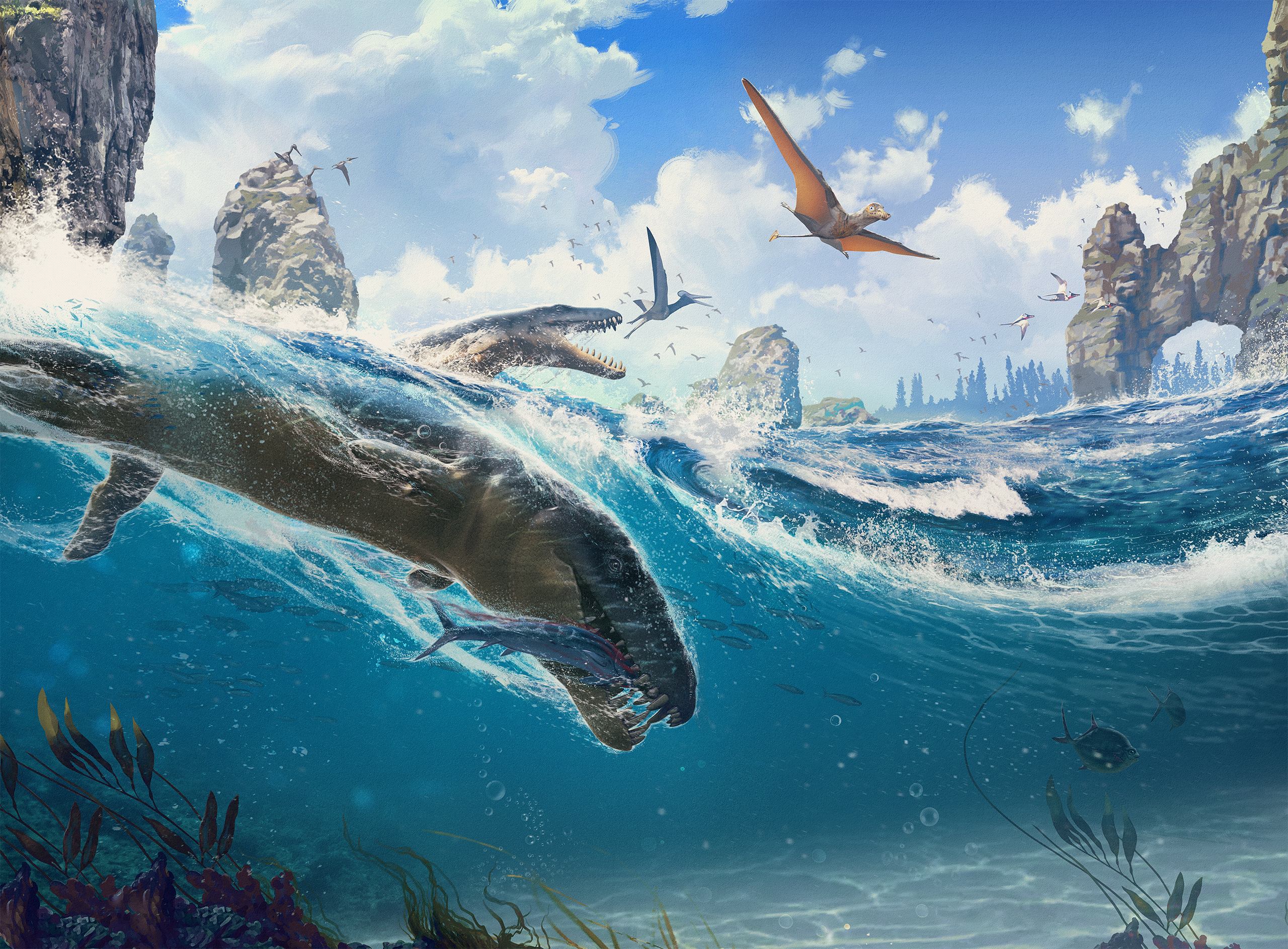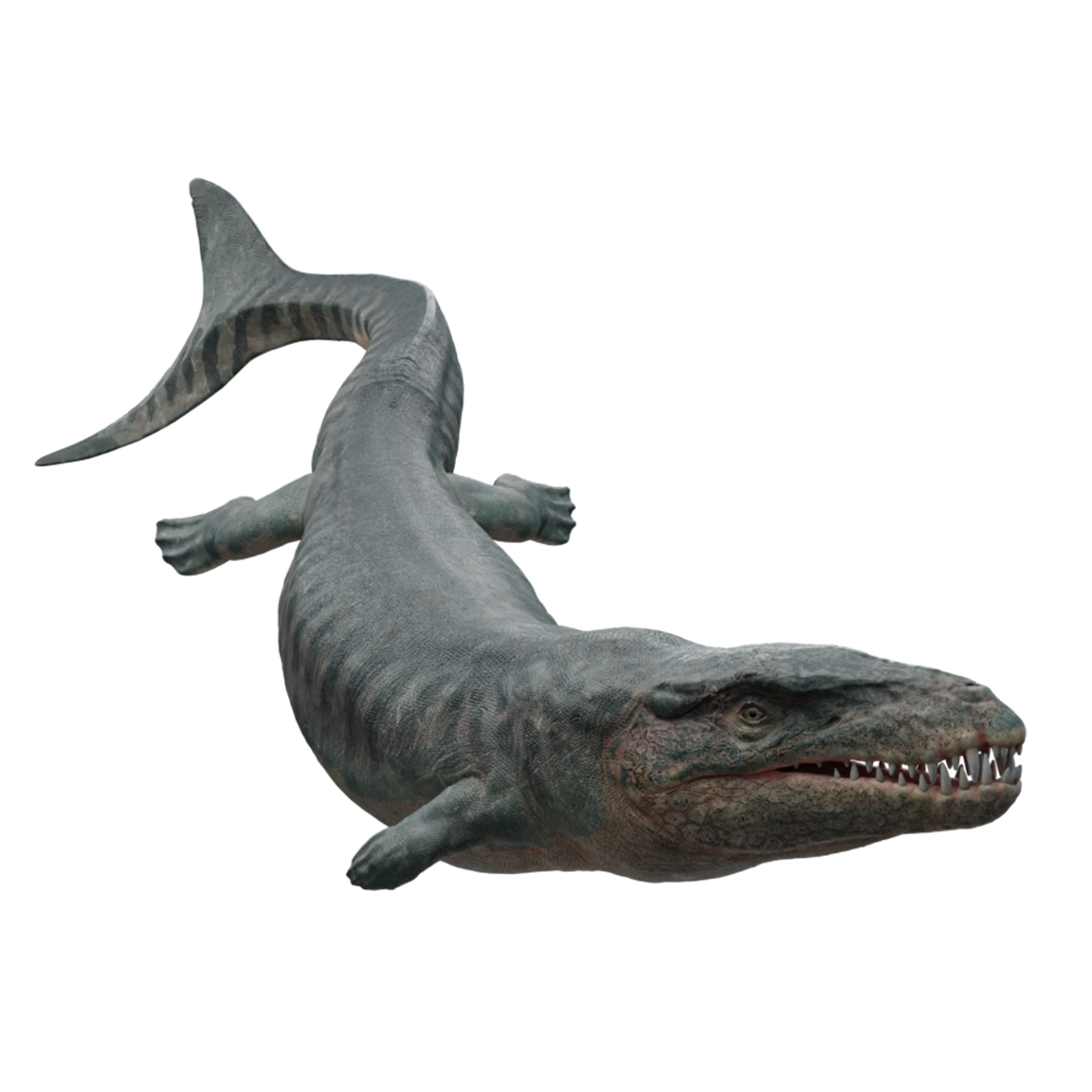The Monster Marine Croc of Solnhofen
In the warm Late Jurassic Lagoon that would become the Solnhofen Limestone of present-day Germany, a monster ruled beneath the waves: the crocodile-relative Dakosaurus. But unlike modern crocodilians, Dakosaurus was entirely marine, living and hunting more like an orca than a crocodile.
Overview: The European seas of the Late Jurassic teemed with life, both fearsome and benign. Marine reptiles such as ichthyosaurs and plesiosaurs hunted fish, while large pliosaurs such as Pliosaurus ate whatever they wanted. Joining these older types of marine reptiles was a group that appeared in the early Jurassic: the thalattosuchians, or marine crocodylomorphs. The most fearsome among them was Dakosaurus, a medium sized predator discovered in the mid-19th Century in the famous Solnhofen Limestone. Unlike modern crocodiles, Dakosaurus and its relatives was entirely adapted for a marine lifestyle, and unique even among its kin, Dakosaurus had powerful jaws and formidable flesh-slicing orca-like teeth, which, despite being smaller than the pliosaurs, nevertheless identify this unique reptile as an apex predator.
Discovery: When the first teeth of Dakosaurus maximus were discovered in Germany, they were mistaken for the those of the theropod dinosaur Megalosaurus. In 1846, based a set of teeth, Theodor Plieninger named Geosaurus maximus. Later, in 1856, Friedrich August von Quenstedt reclassified these teeth not as Geosaurus (though Geosaurus is a close relative) but as a new genus, he named Dakosaurus, meaning “biter lizard” (Greek dakos = “biter”, sauros = lizard) for, said von Quenstedt, “few can match its terrible set of teeth”. The species name “maximus” is Latin, meaning “greatest”. Additional specimens of Dakosaurus maximus have been found in England, France, Switzerland, Germany, Poland, and Russia, along with a second species, D. andiniensis discovered in Argentina, and possible Dakosaurus material discovered in Mexico. Because the holotype (original name bearing specimen) was only teeth, a neotype (a new type specimen selected after the original naming due to a lost/destroyed/undiagnostic holotype) was established in the form of SMNS 8203, housed at the State Museum of Natural History Stuttgart in Stuttgart, Germany.

Evolution, Description, and Ecology: Dakosaurus was a member of the Thalattosuchia, a clade of marine crocodylomorphs that first appeared in the Early Jurassic. The more basal family, teleosauridae, were less adapted for a fully marine lifestyle, but the more advanced family Metriorhynchidae, became fully adapted to life in the seas. They lost their osteoderms (skin armor) in favor of greater streamlining. They developed a shark-like tail fluke for better swimming. Their feet evolved into flippers. Their eyes moved from the top of their heads, typical of a semi-aquatic surface hunter, to a more forward-facing position below the top of the skull, i.e. the skull was less flattened, typical of a fully marine or fully terrestrial predator. And they even probably gave up egg-laying and gave birth to live young, like ichthyosaurs and plesiosaurs, thus completely freeing themselves from the land. Dakosaurus was one of the largest of these marine croc-relatives, at 4–5 m (13–16 ft) long and weighing 200–275 kg (441–606 lbs). It had a shorter, more robust snout, than other thalattosuchians, giving it a more powerful bite, and its teeth, instead of the typical conical teeth of many crocodylomorphs, including many thalattosuchians, were more blade-like, resembling the teeth of a modern orca, indicating that Dakosaurus was adapted for slicing flesh and hunting large prey. Its teeth and powerful bite made it an apex predator, despite being smaller than the largest predator of the European Tethys Sea, Pliosaurus, which would have been twice its length. There is no fossil evidence of interactions between Pliosaurus and Dakosaurus, but they may have preferred to avoid each other, perhaps both being too large and dangerous for each other to hunt, though they likely competed for similar food sources, and if they did interact, the much larger size of Pliosaurus would have made it a threat to Dakosaurus. Dakosaurus probably hunted about whatever it could catch, including large fish and other marine reptiles. It coexisted with three other metriorhynchid thalattosuchians in its environment, Geosaurus giganteus, Cricosaurus suevicus and Rhacheosaurus gracilis. Cricosaurus and Rhacheteosaurus were both smaller and had longer snouts with conical teeth, and probably ate a diet of small fish and squid. Geosaurus had the more robust jaws and shorter snout of Dakosaurus, except it was much smaller, suggesting it was hunting similar to Dakosaurus but on a smaller scale. This niche partitioning is what allowed all of these marine croc-relatives to coexist in the same area.
Extinction and Legacy: Dakosaurus lived in the Late Jurassic and was likely a casualty of the Jurassic-Cretaceous faunal turnover. Thalatosuchians, including Geosaurus and Cricosaurus, continued to inhabit the Mesozoic seas into the Early Cretaceous, disappearing about 125 million years ago, perhaps as a result of climate change and/or competition from other marine reptiles. Perhaps the best place to see Dakosaurus bones on display is the State Museum of Natural History Stuttgart in Stuttgart, Germany, where the neotype is housed.
Dakosaurus FAQ
Dakosaurus size / How big was Dakosaurus?
See weight and length.
Dakosaurus weight / How much did Dakosaurus weigh?
Dakosaurus probably weighed around 200–275 kg (441–606 lb), similar to a medium-sized Nile crocodile.
How long was Dakosaurus?
Dakosaurus was about 4–5 m (13–16 ft) long.
What did Dakosaurus eat?
Dakosaurus was an apex predator, consuming fish and marine reptiles.
What is Dakosaurus’s closest living relative?
The closest living relatives of Dakosaurus are crocodilians like alligators and crocodiles.
Dakosaurus family members / Dakosaurus family / What kind of animal was Dakosaurus?
Dakosaurus was in the family Metriorhynchidae, a family of fully marine crocodile-relatives. Metrorhynchids were in the clade Crocodiliformes which also includes crocodilians.
Where did Dakosaurus live? / Where was Dakosaurus found?
Dakosaurus lived in the Tethys Sea which covered much of Europe, with fossils having been found in Bavaria, Germany.
When did Dakosaurus live?
Dakosaurus lived about 153-148 million years ago during the Late Jurassic Period.
What does Dakosaurus mean? / Dakosaurus name meaning
Dakosaurus means “biter lizard”.

